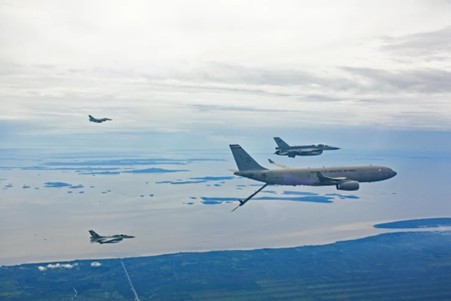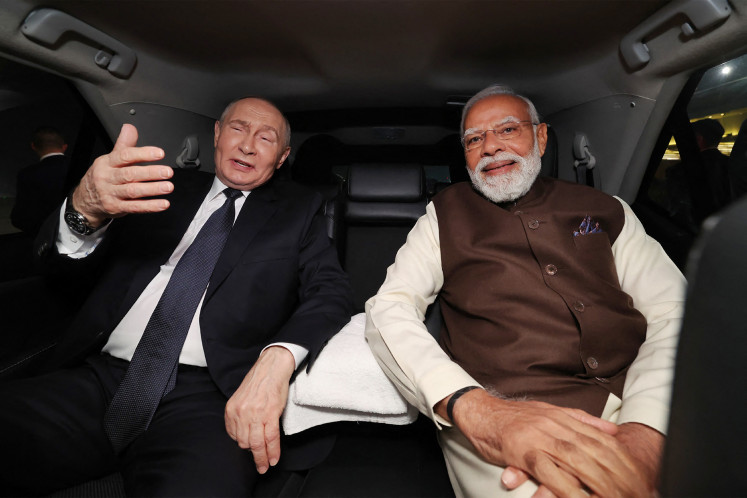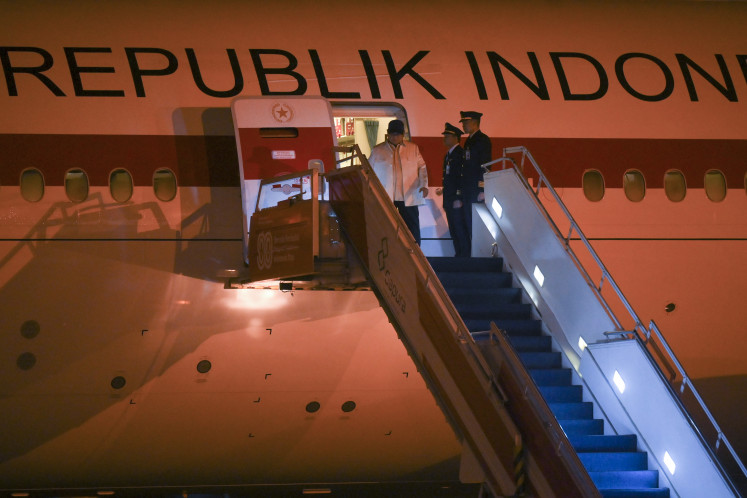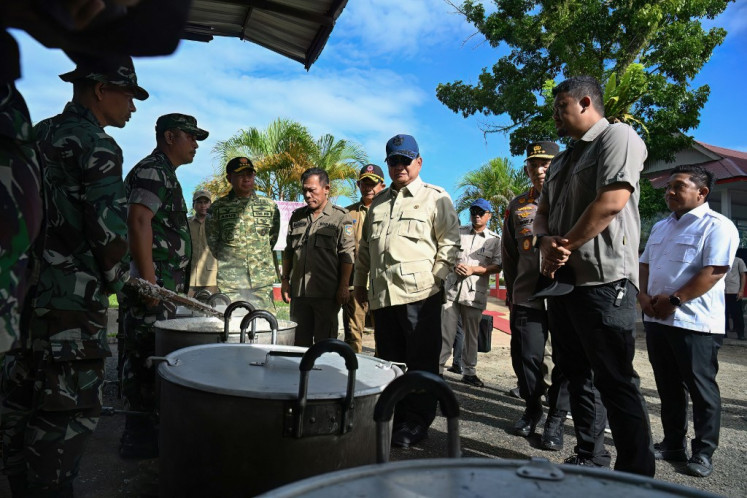Popular Reads
Top Results
Can't find what you're looking for?
View all search resultsPopular Reads
Top Results
Can't find what you're looking for?
View all search resultsAir power is about a system, not merely fighter jets
Today's airpower is defined by a foundational defense system that seamlessly integrates multilayered technologies such as land and space-based detection platforms, missiles, UAVs as well as cyber operations in a centralized command system; one that requires a vision far beyond headline-grabbing aircraft acquisitions for short-term political visibility.
Change text size
Gift Premium Articles
to Anyone
 An Airbus A330 Multi Role Tanker and Transport (MRTT) operated by the 112th squadron of the Republic of Singapore Air Force (right) prepares to refuel two Indonesian Air Force F-16 fighter jets (left) on May 16, 2025, the third day of the 10-day Elang Indopura joint exercise at the Roesmin Noerjadin Air Force Base in Pekanbaru, Riau. (Instagram/@militer.udara)
An Airbus A330 Multi Role Tanker and Transport (MRTT) operated by the 112th squadron of the Republic of Singapore Air Force (right) prepares to refuel two Indonesian Air Force F-16 fighter jets (left) on May 16, 2025, the third day of the 10-day Elang Indopura joint exercise at the Roesmin Noerjadin Air Force Base in Pekanbaru, Riau. (Instagram/@militer.udara)
T
he golden era when fighter jets alone symbolized air superiority has completely faded. That chapter of history is definitively over. In the past, particularly from the Cold War through the 1990s, fighter aircraft like the Grumman F-14 Tomcat were heroic icons, glorified in films such as Top Gun, representing the spearhead of national pride and aerial supremacy.
That paradigm has been fundamentally reshaped, however. The essence of airpower is no longer defined by aggressive-looking jets, but by a fully integrated and multilayered national air defense system (Hanudnas) that must be sophisticated, agile and systemically networked.
The air battle over Kashmir in May between India and Pakistan serves as a compelling illustration. Although advanced aircraft platforms like the Rafale and F-16 were deployed, the decisive outcomes were shaped not by aerial dogfights, but by radar networks, command and control (C2) architecture and information maneuvering capabilities.
Similarly, during the flare-up between Iran and Israel in June, the true game changers were not traditional fighter duels but long-range cruise missiles, drone swarms and satellite-based early warning systems.
Air combat has now transitioned into the domain of cyber operations and algorithmic warfare, where milliseconds and electromagnetic dominance matter far more than sheer speed and thrust.
This is precisely why Indonesia must abandon the outdated metric of airpower as simply the number of fighter jets in its inventory. Pursuing such a populist, procurement-driven approach leads to inefficient defense spending, often driven by narrow political interests tied to five-year election cycles.
In reality, building credible airpower demands farsighted vision, cross-generational planning and institutional continuity that transcends political transitions.
In the modern era, airpower is a complex system. It consists of long-range surveillance radars, real-time C2 centers, passive and active sensors, space-based detection platforms, multirange surface-to-air missile systems and unmanned aerial vehicles (UAVs) for reconnaissance and strike, as well as other elements. Without this complete ecosystem, even the most advanced fighter jet becomes a blind and vulnerable asset in increasingly contested airspaces.
Moreover, air supremacy now hinges on dominance over the electromagnetic spectrum and cyberspace. Discussions of hypersonic missiles and anti-satellite weapons are no longer futuristic: They are today’s operational realities.
As the largest archipelagic nation on Earth, Indonesia faces a uniquely complex challenge. The scale of airspace to monitor, secure and defend is immense. Thus, it is no longer sufficient to merely acquire fifth-generation fighter aircraft.
What is truly required is the development of a comprehensive, adaptive and layered integrated air defense system (IADS) that covers point defense, area defense and anti-access/area-denial (A2/AD) capabilities at strategic locations across the country. Yet none of this is feasible without a grand design, a long-term national defense blueprint that is immune to political whims.
Indonesia must craft a coherent defense white paper and a national airpower road map, developed through interministerial coordination and multiservice collaboration and safeguarded by institutions independent of short-term political cycles. The modernization of Indonesian airpower must move beyond the euphoria of reactive procurement and instead focus on indigenous technological mastery, defense industrialization and the development of skilled and professional human capital.
It is critical to emphasize that no amount of fighter jet acquisitions, regardless of their cost or sophistication, will automatically translate into a credible air defense system. Fighter jets are merely one element within a vastly larger operational matrix. Without seamless integration with radar coverage, missile batteries, sensor networks and centralized command structures, such platforms remain nothing more than window dressing, devoid of real deterrent or combat value.
A resilient air defense architecture cannot be built in fragments. It must rest firmly upon the foundation of the national defense and security system (Sishankamnas) and involve not only the Indonesian Military (TNI) but also key ministries, academic institutions and the domestic defense industry. A truly respected airpower posture will only emerge when it is embedded within a broader, holistic concept of total defense, not through ad hoc, headline-driven acquisition campaigns.
Ultimately, the question is not who owns the most fighter jets, but who can synthesize all defense elements into a coherent system that functions strategically, adapts dynamically and sustains operational superiority across time. Indonesia needs a visionary leadership capable of laying down systemic foundations rather than harvesting short-term popularity.
Without such foresight, we risk remaining spectators in the evolving global theater of air warfare while our own airspace remains alarmingly porous in the face of modern threats.
That said, before venturing further into discussions of multilayered systems or cutting-edge technology, there is one urgent and foundational matter that must be resolved: Indonesia must first and foremost assert full and unequivocal control over its sovereign airspace.
Not a single millimeter of our skies should be under the control or management of foreign entities, as is still the case in parts of our airspace over Riau, Natuna and the Malacca Strait. Without total sovereign control of our own airspace, all talk of strategic planning, sophisticated systems or expensive fighter aircraft will remain a hollow fantasy, an illusion of strength atop a landscape not yet truly independent.
Sovereignty is nonnegotiable. A robust air defense system can only stand firm upon the unshakable foundation of full and undivided national airspace sovereignty.
***
The writer is a former Air Force chief of staff and the founder and chairman of the Indonesia Center for Air Power Studies (ICAPS).










